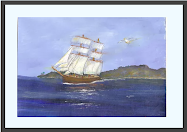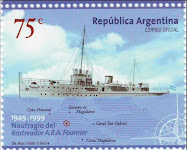El Cutty Sark fue, en 1869, uno de los últimos veleros de tipo clipper en ser construidos. Se conserva en dique seco en Greenwich (Londres). Fue gravemente dañado por un incendio el 21 de mayo de 2007 cuando se encontraba en plena restauración.
Debe su nombre a un personaje de ficción llamado Cutty Sark, una bruja danzarina de un poema cómico de Robert Burns publicado en 1791.
Debe su nombre a un personaje de ficción llamado Cutty Sark, una bruja danzarina de un poema cómico de Robert Burns publicado en 1791.
Fue diseñado por el ingeniero naval Hercules Linton y construido en 1869 en Dumbarton (Escocia) por los astilleros Scott & Linton. Fue botado el 23 de noviembre de ese mismo año.
El Cutty Sark fue destinado al comercio de té que, en aquella época era muy activo en las líneas entre China y Londres. Este comercio generaba grandes beneficios si se llegaba a Gran Bretaña con el primer té de la temporada. Sus inicios no fueron muy prometedores. En la carrera del té de 1872 contra el clipper Thermopylae ambos buques abandonaron Shangai juntos el 18 de junio pero el Cutty Sark quedó descolgado dos semanas después tras sufrir una avería en el timón a su paso por el estrecho de Sunda. Llegó a Londres el 18 de octubre, una semana después que el Thermopylae. A pesar de que había perdido la carrera, el Cutty Sark se hizo famoso porque su capitán prefirió continuar el viaje con un timón improvisado antes que detenerse en un puerto para efectuar las reparaciones.
A finales del siglo XIX los clipper fueron sustituidos por los barcos de vapor en la carrera del té. Podían pasar a través del Canal de Suez y, además, la entrega de la carga era más fiable. El Cutty Sark fue destinado entonces al comercio de lana con Australia. Bajo el mando del respetado capitán Richard Woodget consiguió transportar cargas de lana en sólo 67 días. En esta época consiguió su mejor marca, 360 millas náuticas (666 kilómetros)en 24 horas de navegación a una media de 15 nudos (27,7 km/h).
En 1895 el Cutty Sark fue vendido a la naviera portuguesa Ferreira y se rebautizó con ese nombre. Su tripulación portuguesa, no obstante, se refería al clipper como "Pequena Camisola" que es la traducción de la palabra escocesa "Cutty Sark". En 1916 fue reformado en profundidad, reconvertido en goleta en el puerto de Ciudad de el Cabo (Sudáfrica) y rebautizado como "Maria do Amparo". En 1922 el capitán Wilfred Dowman compró el buque, lo devolvió a su aspecto original y destinó la embarcación como buque de entrenamiento. En 1954 fue llevado a Greenwich y emplazado en dique seco.
El Cutty Sark tiene también su hueco en la literatura gracias al poema de Hart Crane, "The Bridge", publicado en 1930.
El Cutty Sark fue destinado al comercio de té que, en aquella época era muy activo en las líneas entre China y Londres. Este comercio generaba grandes beneficios si se llegaba a Gran Bretaña con el primer té de la temporada. Sus inicios no fueron muy prometedores. En la carrera del té de 1872 contra el clipper Thermopylae ambos buques abandonaron Shangai juntos el 18 de junio pero el Cutty Sark quedó descolgado dos semanas después tras sufrir una avería en el timón a su paso por el estrecho de Sunda. Llegó a Londres el 18 de octubre, una semana después que el Thermopylae. A pesar de que había perdido la carrera, el Cutty Sark se hizo famoso porque su capitán prefirió continuar el viaje con un timón improvisado antes que detenerse en un puerto para efectuar las reparaciones.
A finales del siglo XIX los clipper fueron sustituidos por los barcos de vapor en la carrera del té. Podían pasar a través del Canal de Suez y, además, la entrega de la carga era más fiable. El Cutty Sark fue destinado entonces al comercio de lana con Australia. Bajo el mando del respetado capitán Richard Woodget consiguió transportar cargas de lana en sólo 67 días. En esta época consiguió su mejor marca, 360 millas náuticas (666 kilómetros)en 24 horas de navegación a una media de 15 nudos (27,7 km/h).
En 1895 el Cutty Sark fue vendido a la naviera portuguesa Ferreira y se rebautizó con ese nombre. Su tripulación portuguesa, no obstante, se refería al clipper como "Pequena Camisola" que es la traducción de la palabra escocesa "Cutty Sark". En 1916 fue reformado en profundidad, reconvertido en goleta en el puerto de Ciudad de el Cabo (Sudáfrica) y rebautizado como "Maria do Amparo". En 1922 el capitán Wilfred Dowman compró el buque, lo devolvió a su aspecto original y destinó la embarcación como buque de entrenamiento. En 1954 fue llevado a Greenwich y emplazado en dique seco.
El Cutty Sark tiene también su hueco en la literatura gracias al poema de Hart Crane, "The Bridge", publicado en 1930.
El Cutty Sark es uno de los tres barcos que quedan de la era de los clipper. Posee estructura metálica y cubierta de planchas de madera.
- TRB (Tonelaje de Registro Bruto): 921 toneladas
- Eslora: 64.8 metros
- Manga: 11 metros
- Puntal: 6.4 metros
1870-1878: The China Tea Years

On 16th February 1870, the Cutty Sark left London bound for Shanghai, via the Cape of Good Hope, on her first voyage. Commanded by Captain George Moodie, she carried "large amounts of wine, spirits and beer” (Captain’s abstract log). The arrival of the ship at Shanghai, with “manufactured goods”, is listed in The North China Herald of 2nd June 1870. Departing with around 1,450 tons of tea on 25th June, she arrived back in London on 13th October 1870.
This is the first of 8 voyages the ship successfully made to China in pursuit of tea. However, the Cutty Sark never became the fastest ship on the tea trade. Dogged by bad winds and misfortune, she never lived up to the high expectations of her owner during these years. The closest the ship came to winning the tea race was in 1872, when she had the opportunity to race the Thermopylae head-to-head for the first time.
1878-1883: Tramping for cargoes
Steam ships had arrived onto this market with the opening of the Suez Canal in 1869. The Canal gave the steam ships a quick and direct route from the Mediterranean into the Red Sea, whilst the sailing ships were unable to access the Canal because of their reliance on the trade winds that gusted around the coast of Africa.
Unable to find a tea cargo, Captain Tiptaft died at Shanghai in October 1878. His First Mate, James Wallace, was promoted to the command of the Cutty Sark.
With tea no longer available, the ship started to take different cargoes of various qualities around the world. For example, she took coal from Nagasaki in Japan to Shanghai; jute from Manila to New York; and jute, castor oil, tea and the Australian mail from Calcutta to Melbourne in March 1881.
In 1880, the ship’s First Mate, Sidney Smith, by all accounts a bully and disliked by the crew, killed (with considerable provocation) seaman John Francis. Smith was confined to quarters, but at Anjer Captain Wallace connived at his escape.  The crew, incensed, downed tools and refused to work resulting in most of the sailing being done by the six apprentices and four tradesmen. On 5th September the ship was becalmed in the Java Sea for three days. With the guilt, calm, steaming heat and realisation that his career was finished, Wallace jumped overboard. Although a rescue attempt was mounted, the only sign of Wallace was the number of sharks swimming furiously about…
The crew, incensed, downed tools and refused to work resulting in most of the sailing being done by the six apprentices and four tradesmen. On 5th September the ship was becalmed in the Java Sea for three days. With the guilt, calm, steaming heat and realisation that his career was finished, Wallace jumped overboard. Although a rescue attempt was mounted, the only sign of Wallace was the number of sharks swimming furiously about…
To make matters worse, on arrival at Anjer, William Bruce was transferred from the Hallowe’en and appointed Master of the Cutty Sark. By all accounts, Bruce was an incompetent, drunken master who connived with the Mate to remove the expensive Australian crew members, pocketing their wages. He was also negligent, failing to pick up enough provisions, resulting in the crew becoming half starved. On arrival at New York in April 1882, it appears that an inquiry was held into the conduct of the Master and the First Mate, resulting in them being suspended from service and the crew were given a discharge.
As a result, Captain F. Moore and his Mate were transferred from the Blackadder to the Cutty Sark and it was under his command that the ship embarked upon her most successful period of working life.
1883-1895: The Australian Wool Years
In July 1883, the Cutty Sark left Gravesend bound for Newcastle N.S.W, arriving in October. After loading 4289 bales of wool and 12 casks of tallow, she departed in December 1883 and arrived back in London in March 1884. Her return passage of 83 days was the best of the year, beating every ship sailing at about the same time by 25 days to over a month. This was a remarkable feat, considering that the Cutty Sark was now 14 years old, almost halfway through her expected working life of 30 years.
Captain Moore left the ship in 1885, and was replaced by the most successful Master who ever commanded the Cutty Sark; Richard Woodget. Captain Woodget’s skill lay as a successful man-manager and fearless navigator, getting the best out of both the ship and his crew. In order to catch the Roaring Forties trade winds, encountering some of the most violent gales and seas on Earth, Woodget would travel further south than any previous commander. This was perilous, as the ship came into frequent contact with icebergs around Cape Horn (the southern tip of South America). Woodget was also a keen photographer and he has left many striking images of the ship passing icebergs as well as shots of her in Sydney harbour.
Fortunately, the ship survived and produced stunning passage times. On his first voyage in command, the ship sailed from England to Sydney in 77 days, and returned to the UK from Australia in 73 days. This was the start of 10 years domination by the Cutty Sark in the wool trade. The ship soon established herself as the fastest vessel, the ‘last chance’ ship to make the English January wool sales.
In July 1889, the Cutty Sark was involved in a famous incident with the crack P&O steam ship Britannia. On the night of the 25th July, Britannia, doing between 14.5 and 16 knots, was overhauled by the Cutty Sark doing a good 17 knots. Robert Olivey, Second Officer on Britannia, watched the lights of the sailing ship overhauling his vessel with amazement and called Captain Hector. Neither could have known it was Cutty Sark, and Britannia’s log read with great amazement, “Sailing ship overhauled and passed us!”
In January 2006, letters written by Clarence Ray (apprentice on board the Cutty Sark in 1894) were brought to light by Dick Ray, his great-nephew. This important archive reveals how a fifteen year old boy lived and worked alongside his shipmates. In particular, he writes to his mother about the food on board the ship (including the delights of "Salt Tram Horse", "Leu Pie" and "Junk and Spuds"), dodging Captain Woodget's vicious collie-dogs, how the ship was swamped by the sea in bad weather and his duties, which included rowing the Master ashore for picnics, while the ship was in harbour.
As steam-ships moved further into the wool trade in the 1890s, the Cutty Sark began to make less money for her owner. After the ship returned to the UK from Brisbane in 1895, Jock Willis sold her to a Portuguese firm, J. Ferreira & Co. for £2,100. Woodget transferred to the Coldinghame, and the Cutty Sark left British ownership.
1895-1922: The Portuguese Years
After being sold to J. Ferreira & Co. Cutty Sark was renamed the Ferreira. Reminiscent of her days in the late 1870s and early 1880s, Ferreira tramped various cargoes mainly between Portugal and her empire, and was a regular visitor to Rio, New Orleans, Mozambique, Angola and the UK. In the twentieth century she traded regularly between Oporto, Rio, New Orleans and Lisbon, and her crew claimed she was still capable of doing sixteen knots.
In October 1915 Portugal declared war on Germany which meant that the ship was in constant danger of being sunk by enemy naval activity. She survived unscathed until May 1916, when the rolling of the ship in bad weather led to the dismasting of the main mast and everything above the fore lowermast and the mizzen top-masts. Badly damaged, Ferreira was towed into port, arriving at Table Bay, South Africa. The cost and rarity of adequate masts and yards due to the war meant that she was converted into a barquentine (fore and aft rig) over an eighteen month period at Cape Town.
In 1923 her old name and nationality was restored; the Cutty Sark had returned to British ownership.
1922-1938: The Falmouth Years
A restored Cutty Sark in Falmouth harbour, around 1924
After saving the Cutty Sark for the nation, Wilfred Dowman restored the ship to a close approximation of her appearance as a tea and wool clipper. This was a considerable feat, due to the shortage of necessary materials caused by the First World War. She was also the first historic vessel since Drake’s Golden Hind in the sixteenth century to be opened to the public, and oral history interviews have revealed how boatmen used to take many visitors out to the ship.
The Cutty Sark was used as a cadet training ship, where half a dozen boys from different backgrounds would live on board and train for a career in either the Royal Navy or the Merchant Marine.
However, Captain Dowman died in 1936, and his widow decided that she was unable to maintain the ship at her own cost. Therefore, the Cutty Sark was sold to the Incorporated Thames Nautical Training College, Greenhithe, and left Falmouth in 1938 accompanied by cheers from well-wishers and hoots from vessels in the harbour. This was the last time that she went to sea.
1938-1954: The Years
Cutty Sark alongside HMS Worcester, Greenhithe, around 1938
In 1938, the Cutty Sark arrived in Greenhithe, Kent, as an auxiliary vessel for the cadet training ship HMS Worcester. The ship continued her role in training officers for service in the Royal and Merchant Navies, which was soon to be vital with the outbreak of the Second World War in 1939.
In her early days at Kent, the ship was regularly used for sail-training drill and was lovingly maintained by cadets who were inspired by the ship’s record-breaking history. However, by the early 1950s, the College acquired a newer training vessel and were unwilling to keep the Cutty Sark. A new home had to be found.
In 1951, the ship was sent to London, to be moored in the Thames as part of the Festival of Britain celebrations. Returning to Greenhithe, it was not long before her plight became noticed by those determined to save her from the scrap-yard.
The Cutty Sark Society was formed by Frank Carr, Director of the National Maritime Museum, and patronised by HRH The Duke of Edinburgh. In a special ceremony, just before the coronation of Queen Elizabeth II, Prince Philip took possession of Cutty Sark on behalf of the the society.
1954 - date: The Greenwich Years
In December 1954, in an event of such significance it was captured by BBC cameras, the Cutty Sark was towed into a specially constructed dry dock at Greenwich. Three years of painstaking restoration work followed, taking the ship back to her tea clipper appearance. She has remained in Greenwich, in her dry-dock, to this day.
Why is the ship called the Cutty Sark? The Burns Story
Painting of Tam O'Shanter. Nannie (left) is wearing her"cutty sark"
There is an old Scottish legend that was later turned into a story by Robert Burns. This story is about a farmer called Tam O'Shanter.
It was very late on a dark and stormy night when Tam, who had been to Market to sell his wares and had called at the local inn afterwards for a few drinks, began his journey home. Tam was riding his old mare Meg down a lonely road, when he drew close to the church at Kirk Alloway.
Through the cold night air he heard a strange and scary sound, and as he looked into the night sky he saw the glare of fire!
There, in the churchyard, dancing around a huge bonfire was a coven of witches and warlocks. Tam sat on his horse, rigid with terror! The witches danced on and Tam noticed that one of the hags was younger and more beautiful than the others. Her name was Nannie, but Tam didn't know this; all she was wearing was a short petticoat so he called her 'cutty sark', which is an old regional Scottish name for this garment.
Well, the dancing became wilder and wilder and Tam became more and more engrossed. At last, he could bear the suspense no longer and he shouted out,
"Weel done 'cutty sark'!"
With a flash the bonfire went out, and a soul-tearing howl went up from the witches and warlocks, as they began to race towards Tam, desperate to get to this mortal who had ruined their revelry.
Poor Tam. He was in fear of his life, and for a moment just sat there, but after a few seconds that seemed like lifetimes, he managed to spur Meg on, in a desperate race to save his life.
Now, witches cannot cross running water, and fortunately for Tam, the river Doon was nearby. He set Meg galloping madly towards the bridge, with the witches in hot pursuit.
Nannie, being younger and faster than the rest, was the closest to him, and was reaching out to grab Meg’s tail, just as the mare reached the bridge.
Luckily for Tam (although not so for Meg), the horse's tail came away in Nannie's hand just as the mare galloped over the bridge. Tam was saved! The witches and warlocks stood on the river-bank cursing and screaming at Tam who had had a very narrow escape.
This was the story that inspired the naming of the Cutty Sark. Although we do not know why the name was chosen, Jock Willis was a well-read man who enjoyed poetry. During his time as a ship's captain, he would read French novels in his cabin. He also named one of his other ships the Hallowe'en, the title of another Burns poem. Although "cutty sark" was a little unusual, it certainly suits a sleek, swift tea clipper, giving her an air of magic and mystery.












No hay comentarios:
Publicar un comentario